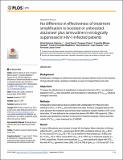Por favor, use este identificador para citar o enlazar a este item:
http://hdl.handle.net/10261/180800COMPARTIR / EXPORTAR:
 SHARE SHARE
 CORE
BASE CORE
BASE
|
|
| Visualizar otros formatos: MARC | Dublin Core | RDF | ORE | MODS | METS | DIDL | DATACITE | |

| Título: | No difference in effectiveness of treatment simplification to boosted or unboosted atazanavir plus lamivudine in virologically suppressed in HIV-1-infected patients |
Autor: | Gutiérrez Valencia, Alicia CSIC ORCID; García, Coral; Viciana, Pompeyo CSIC; Milanés-Guisado, Yusnelkis CSIC; Fernández-Magdaleno, Tamara CSIC; Espinosa, Nuria CSIC ORCID; Pasquau-Liaño, Juan; López-Cortés, Luis F. CSIC ORCID | Fecha de publicación: | 20-sep-2018 | Editor: | Public Library of Science | Citación: | PLoS ONE 13(9): e0203452 (2018) | Resumen: | [Background] Simplification strategies of antiretroviral treatment represent effective tools for the reduction of drug-induced toxicity, resistance mutations in case of virological failure and costs. [Objectives] To assess the effectiveness of simplification to atazanavir/ritonavir (ATVrtv) or unboosted atazanavir (ATV400) plus lamivudine, and if low plasma or intracellular ATV Ctrough influence virological outcomes. [Methods] Ambispective observational study in patients with undetectable HIV-RNA who were switched to ATVrtv or ATV400 plus lamivudine once daily. Previous virological failures (VF) were allowed if the resistance tests showed major resistance mutation neither to ATV nor to lamivudine. VF was defined as two consecutive plasma HIV-RNA >200 copies/mL. Effectiveness was assessed by intention-to-treat and on-treatment analyses. Plasma and intracellular ATV Ctrough were measured by LC-MS/MS. [Result] A total of 246 patients were included. At week 48, the Kaplan–Meier estimation of efficacy within the ATVrtv and ATV400 groups were 85.9% [95% confidence interval, (CI95), 80.3–91.4%] versus 87.6% (CI95, 80.1–94.1%) by intention-to-treat analysis (p = 0.684), and 97.7% (CI95, 95.2–100%) versus 98.8% (CI95, 97.0–100%) by on-treatment analysis (p = 0.546), respectively. Plasma and intracellular Ctrough were significantly higher with ATVrtv than with ATV400 (geometric mean (GM), 318.3 vs. 605.9 ng/mL; p = 0.013) and (811.3 vs. 2659.2 ng/mL; p = 0.001), respectively. Only 14 patients had plasma Ctrough below the suggested effective concentration for ATV (150 ng/mL). No relationship between plasma or intracellular Ctrough and VF or blips were found. [Conclusion] Boosted or unboosted ATV plus lamivudine is effective and safe, and the lower plasma Ctrough observed with ATV400 do not compromise the effectiveness of these simplification regimens in long-term virologically suppressed HIV-1-infected patients. |
Versión del editor: | https://doi.org/10.1371/journal.pone.0203452 | URI: | http://hdl.handle.net/10261/180800 | DOI: | 10.1371/journal.pone.0203452 | E-ISSN: | 1932-6203 |
| Aparece en las colecciones: | (IBIS) Artículos |
Ficheros en este ítem:
| Fichero | Descripción | Tamaño | Formato | |
|---|---|---|---|---|
| journal.pone.0203452.pdf | 844,46 kB | Adobe PDF |  Visualizar/Abrir |
CORE Recommender
SCOPUSTM
Citations
3
checked on 19-abr-2024
WEB OF SCIENCETM
Citations
1
checked on 25-feb-2024
Page view(s)
228
checked on 24-abr-2024
Download(s)
143
checked on 24-abr-2024
Google ScholarTM
Check
Altmetric
Altmetric
Este item está licenciado bajo una Licencia Creative Commons

